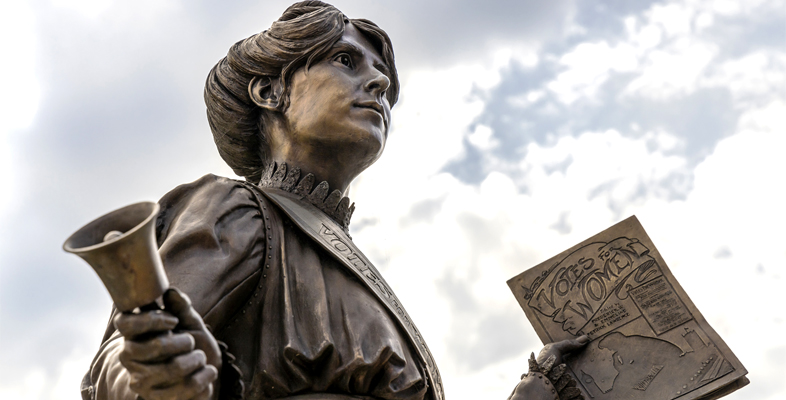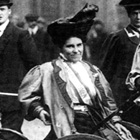6.1 May Billinghurst
The life stories of many of the leaders of the suffrage campaign make for fascinating reading. They were utterly dedicated, passionate idealists, who fought valiantly for their cause.
It is important to note, however, that they were also individuals with distinctive personalities. You’re going to investigate one notable example in more detail in this section: May Billinghurst.
In order to find out about Billinghurst, you will use an ODNB resource again.
Activity 8 May Billinghurst
Read the biography below and answer the following questions, either in the text boxes below or in your learning notebook:
(Rosa) May Billinghurst biography [Tip: hold Ctrl and click a link to open it in a new tab. (Hide tip)]
Why do you think that May Billinghurst became a suffragette?
Discussion
The account gives a specific reason for Billinghurst’s commitment to women’s suffrage: the injustices that she had witnessed when working in London to rescue young girls from prostitution. This reflects an important truth about the women’s suffrage movement – the vote was sought not just as a goal in itself, but as a means by which to improve the lives of women in society as a whole. The same had been true of the Chartists, who had seen getting the vote as a means of forcing the state to take better care of its citizens.
Did Billinghurst’s disability stop her from taking part in suffragette activities?
Discussion
Billinghurst’s disability didn’t stop her from taking part in suffragette activities. Moving about by tricycle, she organised public meetings, took part in demonstrations, was arrested, went on hunger strike and was force-fed. The ODNB entry does not mention this, but there are also reports of her being present in an attempt by a group of suffragettes to force an entry to Buckingham Palace on 21 May 1914 (Crawford, 2001, p. 54).
What personal qualities and beliefs might have sustained her in her efforts?
Discussion
A central motivation for Billinghurst was her lifelong commitment to women’s causes, which started before her involvement with the suffragettes, and continued many years afterwards. It is also interesting to note the references to her sense of humour, courage and belief in reincarnation, all of which may have helped her to persevere.
When reading a biographical account of a prominent suffragette, it is important to remember that the women’s suffrage movement drew on the support of tens of thousands of people (men as well as women), without whom the campaign for votes for women would have got nowhere. The great majority of these supporters, who may themselves have led extraordinary lives, will never have biographies written about them.
However, biography is still a useful pathway into the past. As you may have noticed from the discussion of the ODNB above, when you study an individual person’s life, you often end up thinking more broadly about the times in which they lived. A good biography seeks to interpret an individual in context, because this is necessary in order to understand both their formation and their motivations. It can stretch to include many aspects of the subject’s contemporary world. It also helps the reader to take notice of the context and to learn more about it. The life story of a memorable individual can gain readers’ attention very successfully, combining as it does elements readers may recognise, as well as those which might be very different, in the story of a life. The best examples combine all the literary skills employed in good story writing (character development, techniques to set the scene, plot development, perhaps even suspense!) with the historical perspective, helping to explain the past in more general as well as individual terms, and, by extension, the present as well.

